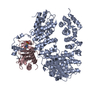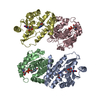+ Open data
Open data
- Basic information
Basic information
| Entry | Database: EMDB / ID: EMD-7056 | |||||||||
|---|---|---|---|---|---|---|---|---|---|---|
| Title | Dimer of stromal portion of ARC6 | |||||||||
 Map data Map data | Stromal portion of ARC6 | |||||||||
 Sample Sample |
| |||||||||
 Keywords Keywords | ARC6 / plastid / chloroplast / FtsZ / STRUCTURAL PROTEIN | |||||||||
| Biological species |  | |||||||||
| Method | single particle reconstruction / negative staining / Resolution: 22.0 Å | |||||||||
 Authors Authors | Sung MW | |||||||||
 Citation Citation |  Journal: J Biol Chem / Year: 2018 Journal: J Biol Chem / Year: 2018Title: The chloroplast division protein ARC6 acts to inhibit disassembly of GDP-bound FtsZ2. Authors: Min Woo Sung / Rahamthulla Shaik / Allan D TerBush / Katherine W Osteryoung / Stanislav Vitha / Andreas Holzenburg /  Abstract: Chloroplasts host photosynthesis and fulfill other metabolic functions that are essential to plant life. They have to divide by binary fission to maintain their numbers throughout cycles of cell ...Chloroplasts host photosynthesis and fulfill other metabolic functions that are essential to plant life. They have to divide by binary fission to maintain their numbers throughout cycles of cell division. Chloroplast division is achieved by a complex ring-shaped division machinery located on both the inner (stromal) and the outer (cytosolic) side of the chloroplast envelope. The inner division ring (termed the Z ring) is formed by the assembly of tubulin-like FtsZ1 and FtsZ2 proteins. ARC6 is a key chloroplast division protein that interacts with the Z ring. ARC6 spans the inner envelope membrane, is known to stabilize or maintain the Z ring, and anchors the Z ring to the inner membrane through interaction with FtsZ2. The underlying mechanism of Z ring stabilization is not well-understood. Here, biochemical and structural characterization of ARC6 was conducted using light scattering, sedimentation, and light and transmission EM. The recombinant protein was purified as a dimer. The results indicated that a truncated form of ARC6 (tARC6), representing the stromal portion of ARC6, affects FtsZ2 assembly without forming higher-order structures and exerts its effect via FtsZ2 dynamics. tARC6 prevented GDP-induced FtsZ2 disassembly and caused a significant net increase in FtsZ2 assembly when GDP was present. Single particle analysis and 3D reconstruction were performed to elucidate the structural basis of ARC6 activity. Together, the data reveal that a dimeric form of tARC6 binds to FtsZ2 filaments and does not increase FtsZ polymerization rates but rather inhibits GDP-associated FtsZ2 disassembly. | |||||||||
| History |
|
- Structure visualization
Structure visualization
| Movie |
 Movie viewer Movie viewer |
|---|---|
| Structure viewer | EM map:  SurfView SurfView Molmil Molmil Jmol/JSmol Jmol/JSmol |
| Supplemental images |
- Downloads & links
Downloads & links
-EMDB archive
| Map data |  emd_7056.map.gz emd_7056.map.gz | 160.3 KB |  EMDB map data format EMDB map data format | |
|---|---|---|---|---|
| Header (meta data) |  emd-7056-v30.xml emd-7056-v30.xml emd-7056.xml emd-7056.xml | 9.1 KB 9.1 KB | Display Display |  EMDB header EMDB header |
| Images |  emd_7056.png emd_7056.png | 24.6 KB | ||
| Archive directory |  http://ftp.pdbj.org/pub/emdb/structures/EMD-7056 http://ftp.pdbj.org/pub/emdb/structures/EMD-7056 ftp://ftp.pdbj.org/pub/emdb/structures/EMD-7056 ftp://ftp.pdbj.org/pub/emdb/structures/EMD-7056 | HTTPS FTP |
-Validation report
| Summary document |  emd_7056_validation.pdf.gz emd_7056_validation.pdf.gz | 387 KB | Display |  EMDB validaton report EMDB validaton report |
|---|---|---|---|---|
| Full document |  emd_7056_full_validation.pdf.gz emd_7056_full_validation.pdf.gz | 386.5 KB | Display | |
| Data in XML |  emd_7056_validation.xml.gz emd_7056_validation.xml.gz | 4.9 KB | Display | |
| Data in CIF |  emd_7056_validation.cif.gz emd_7056_validation.cif.gz | 5.4 KB | Display | |
| Arichive directory |  https://ftp.pdbj.org/pub/emdb/validation_reports/EMD-7056 https://ftp.pdbj.org/pub/emdb/validation_reports/EMD-7056 ftp://ftp.pdbj.org/pub/emdb/validation_reports/EMD-7056 ftp://ftp.pdbj.org/pub/emdb/validation_reports/EMD-7056 | HTTPS FTP |
-Related structure data
- Links
Links
| EMDB pages |  EMDB (EBI/PDBe) / EMDB (EBI/PDBe) /  EMDataResource EMDataResource |
|---|
- Map
Map
| File |  Download / File: emd_7056.map.gz / Format: CCP4 / Size: 251 KB / Type: IMAGE STORED AS FLOATING POINT NUMBER (4 BYTES) Download / File: emd_7056.map.gz / Format: CCP4 / Size: 251 KB / Type: IMAGE STORED AS FLOATING POINT NUMBER (4 BYTES) | ||||||||||||||||||||||||||||||||||||||||||||||||||||||||||||||||||||
|---|---|---|---|---|---|---|---|---|---|---|---|---|---|---|---|---|---|---|---|---|---|---|---|---|---|---|---|---|---|---|---|---|---|---|---|---|---|---|---|---|---|---|---|---|---|---|---|---|---|---|---|---|---|---|---|---|---|---|---|---|---|---|---|---|---|---|---|---|---|
| Annotation | Stromal portion of ARC6 | ||||||||||||||||||||||||||||||||||||||||||||||||||||||||||||||||||||
| Projections & slices | Image control
Images are generated by Spider. | ||||||||||||||||||||||||||||||||||||||||||||||||||||||||||||||||||||
| Voxel size | X=Y=Z: 5.1 Å | ||||||||||||||||||||||||||||||||||||||||||||||||||||||||||||||||||||
| Density |
| ||||||||||||||||||||||||||||||||||||||||||||||||||||||||||||||||||||
| Symmetry | Space group: 1 | ||||||||||||||||||||||||||||||||||||||||||||||||||||||||||||||||||||
| Details | EMDB XML:
CCP4 map header:
| ||||||||||||||||||||||||||||||||||||||||||||||||||||||||||||||||||||
-Supplemental data
- Sample components
Sample components
-Entire : ARC6
| Entire | Name: ARC6 |
|---|---|
| Components |
|
-Supramolecule #1: ARC6
| Supramolecule | Name: ARC6 / type: organelle_or_cellular_component / ID: 1 / Parent: 0 / Macromolecule list: all |
|---|---|
| Source (natural) | Organism:  |
| Molecular weight | Theoretical: 106.9 KDa |
-Macromolecule #1: ARC6
| Macromolecule | Name: ARC6 / type: other / ID: 1 / Classification: other |
|---|---|
| Sequence | String: DFYQVLGAQT HFLTDGIRRA FEARVSKPPQ FGFSDDALIS RRQILQAACE TLSNPRSRRE YNEGLLDDEE ATVITDVPWD KVPGALCVLQ EGGETEIVLR VGEALLKERL PKSFKQDVVL VMALAFLDVS RDAMALDPPD FITGYEFVEE ALKLLQEEGA SSLAPDLRAQ ...String: DFYQVLGAQT HFLTDGIRRA FEARVSKPPQ FGFSDDALIS RRQILQAACE TLSNPRSRRE YNEGLLDDEE ATVITDVPWD KVPGALCVLQ EGGETEIVLR VGEALLKERL PKSFKQDVVL VMALAFLDVS RDAMALDPPD FITGYEFVEE ALKLLQEEGA SSLAPDLRAQ IDETLEEITP RYVLELLGLP LGDDYAAKRL NGLSGVRNIL WSVGGGGASA LVGGLTREKF MNEAFLRMTA AEQVDLFVAT PSNIPAESFE VYEVALALVA QAFIGKKPHL LQDADKQFQQ LQQAKVMAME IPAMLYDTRN NWEIDFGLER GLCALLIGKV DECRMWLGLD SEDSQYRNPA IVEFVLENSN RDDNDDLPGL CKLLETWLAG VVFPRFRDTK DKKFKLGDYY DDPMVLSYLE RVEVVQGSPL AAAAAMARIG A |
-Experimental details
-Structure determination
| Method | negative staining |
|---|---|
 Processing Processing | single particle reconstruction |
| Aggregation state | particle |
- Sample preparation
Sample preparation
| Concentration | 0.07 mg/mL |
|---|---|
| Buffer | pH: 7.5 |
| Staining | Type: NEGATIVE / Material: 2% Uranyl Acetate |
| Grid | Material: COPPER / Support film - Material: CARBON / Support film - topology: CONTINUOUS |
- Electron microscopy
Electron microscopy
| Microscope | JEOL 1200EX |
|---|---|
| Image recording | Film or detector model: SIA 15C (3k x 3k) / Average electron dose: 2.0 e/Å2 |
| Electron beam | Acceleration voltage: 100 kV / Electron source: TUNGSTEN HAIRPIN |
| Electron optics | Illumination mode: OTHER / Imaging mode: OTHER |
- Image processing
Image processing
| Startup model | Type of model: OTHER / Details: reference free class averages |
|---|---|
| Final reconstruction | Applied symmetry - Point group: C2 (2 fold cyclic) / Resolution.type: BY AUTHOR / Resolution: 22.0 Å / Resolution method: FSC 0.5 CUT-OFF / Software - Name: EMAN (ver. 1) / Number images used: 4121 |
| Initial angle assignment | Type: COMMON LINE |
| Final angle assignment | Type: OTHER |
 Movie
Movie Controller
Controller



 UCSF Chimera
UCSF Chimera







 Z (Sec.)
Z (Sec.) Y (Row.)
Y (Row.) X (Col.)
X (Col.)





















